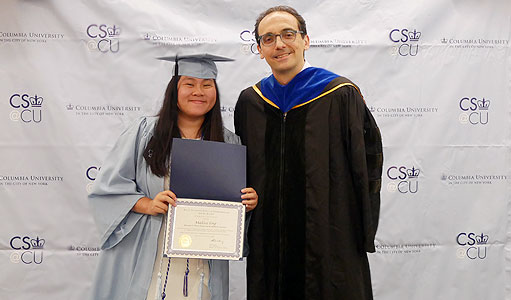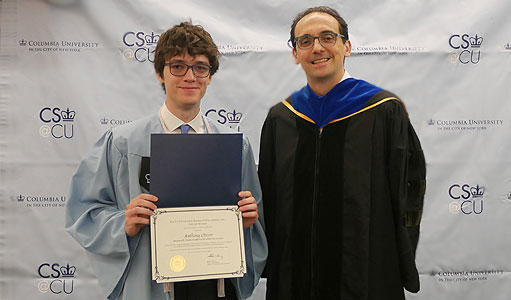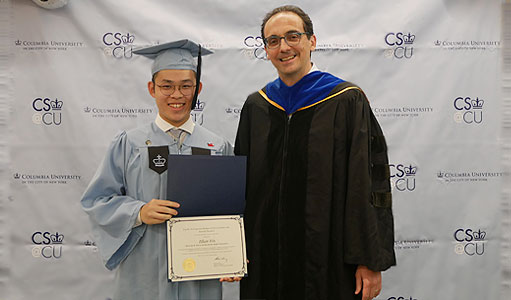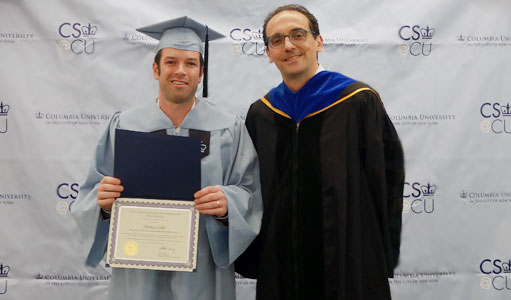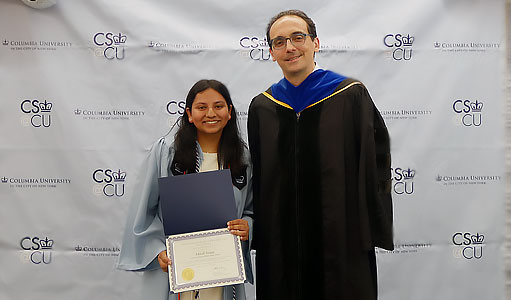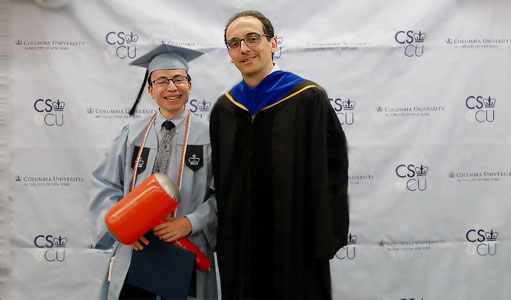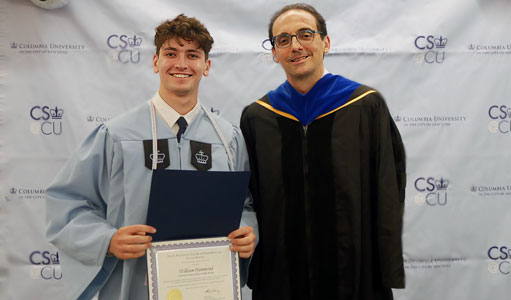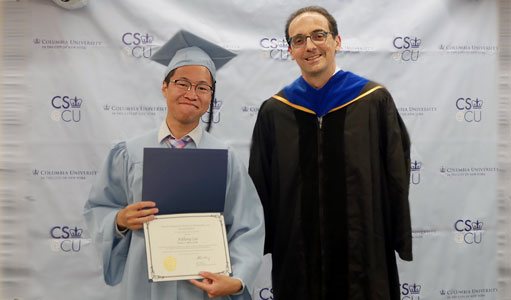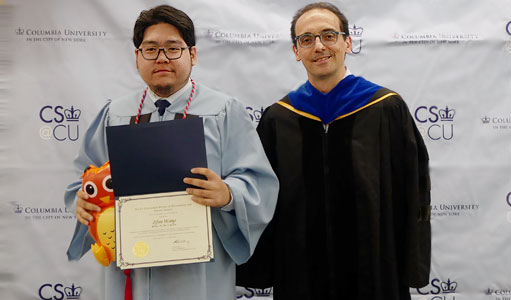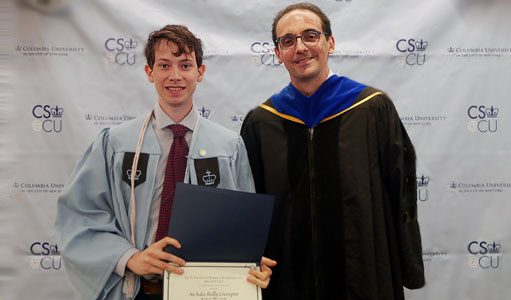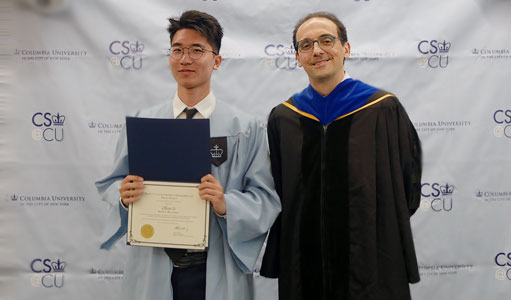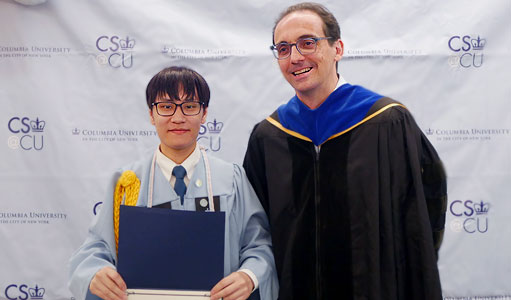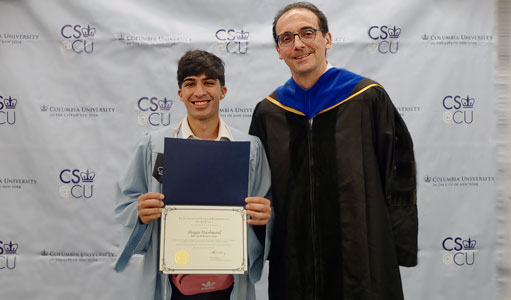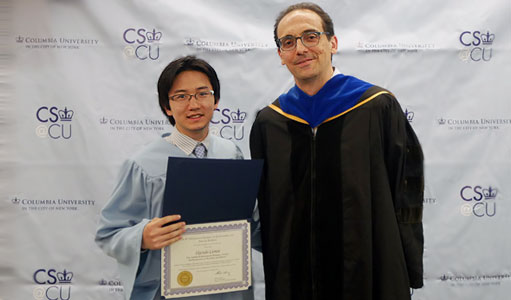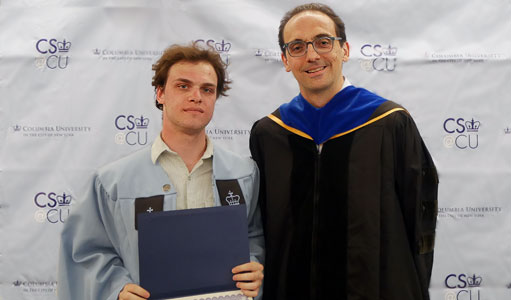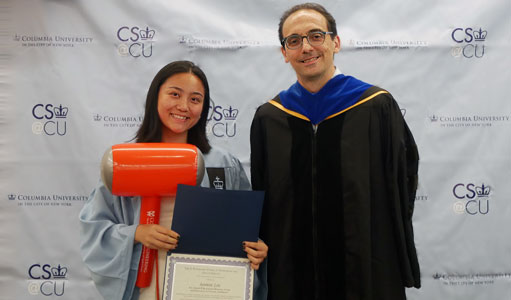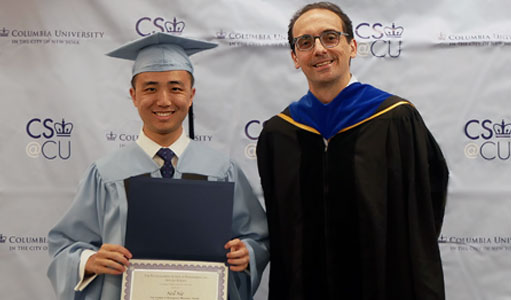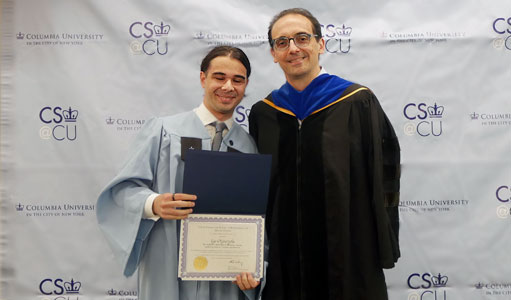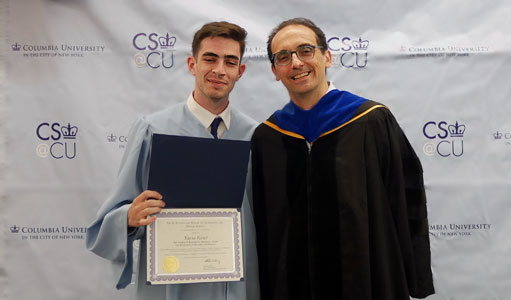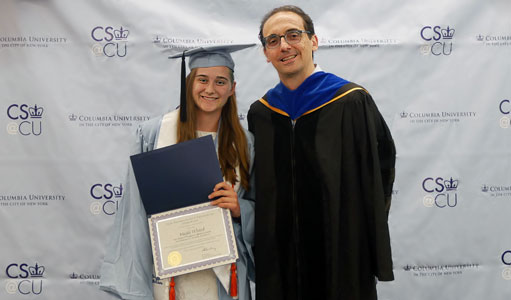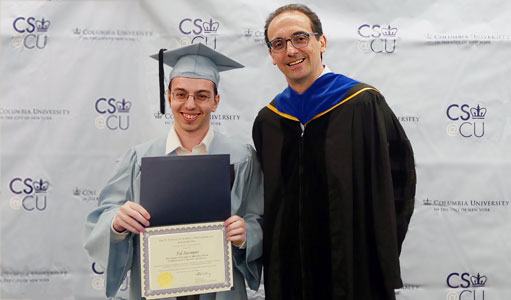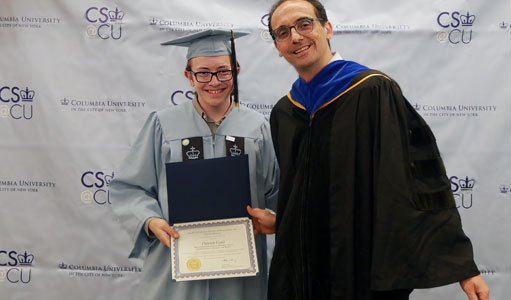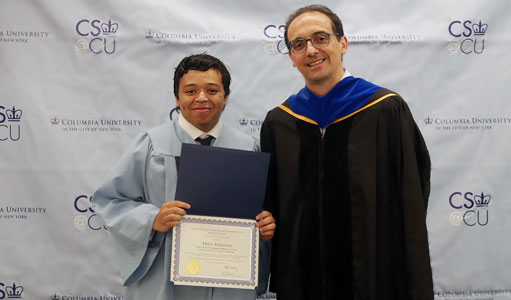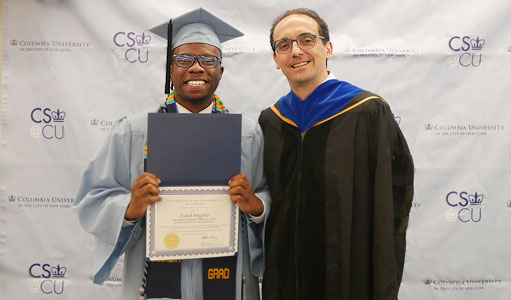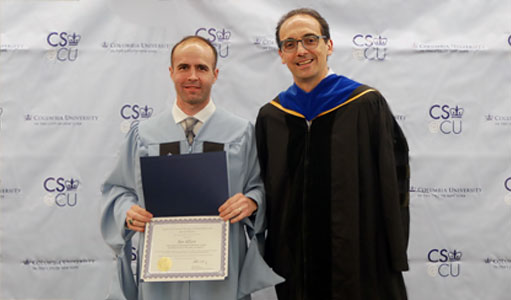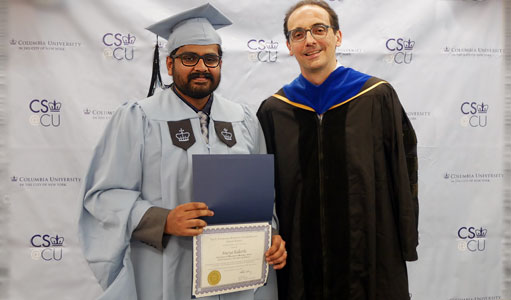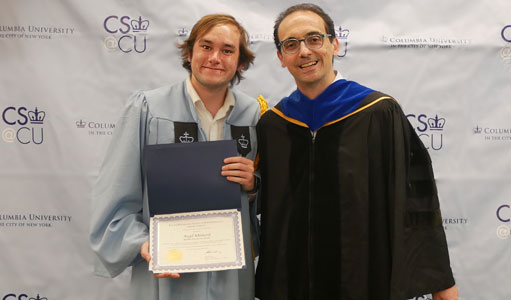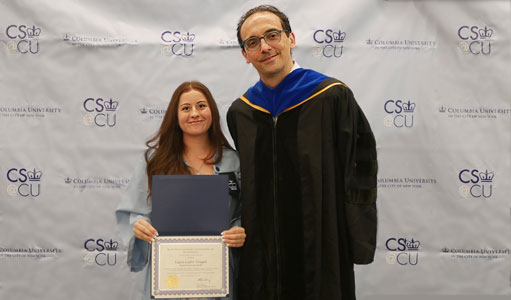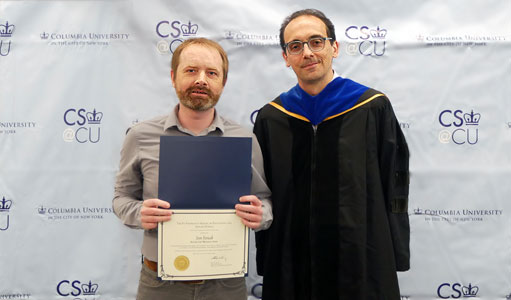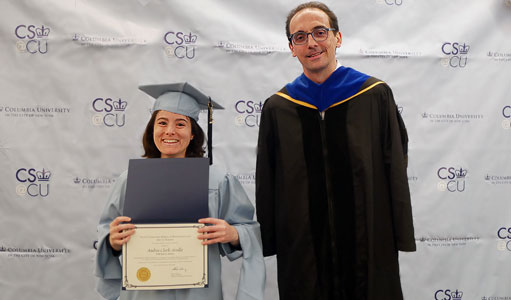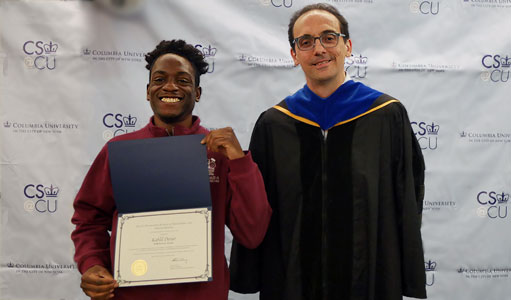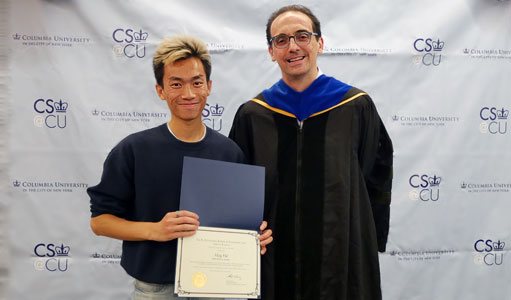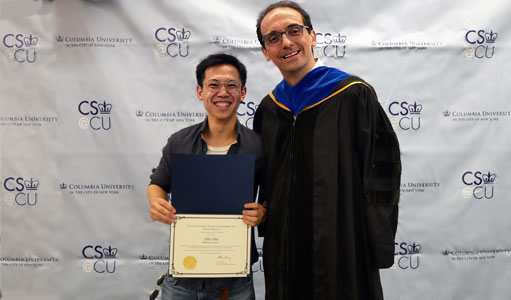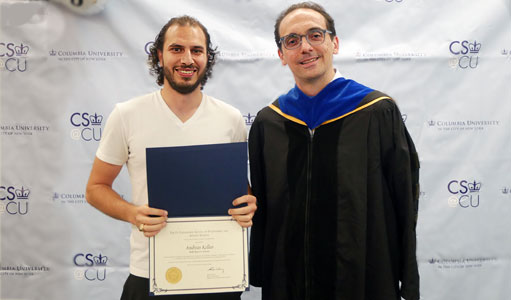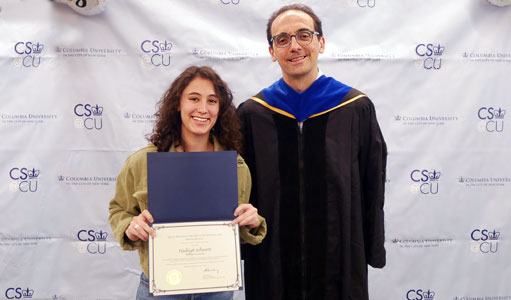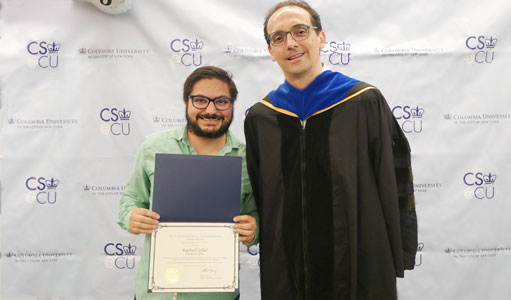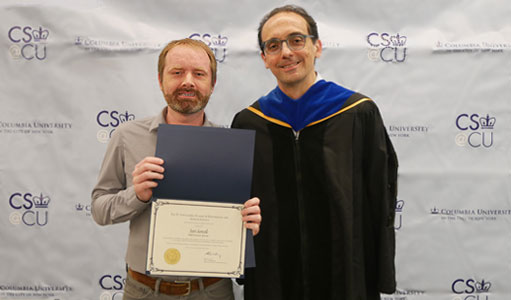Month: May 2023
Congratulations to the Class of 2023!
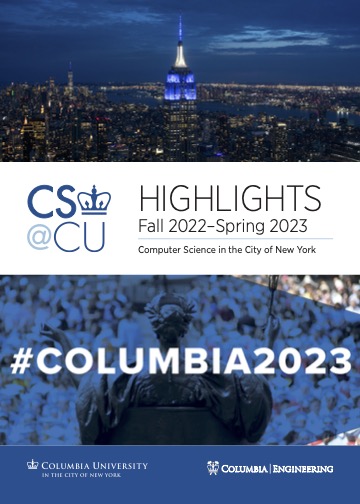 The department is extremely proud of all of our students! We honored this year’s graduates at a post-commencement event on May 17.
The department is extremely proud of all of our students! We honored this year’s graduates at a post-commencement event on May 17.
A number of students received awards from the department for their service and academic excellence. The list of CS awardees is in this year’s graduation handout.
University commencement was on May 17 and on May 15, the Columbia Engineering Class of 2023 gathered on the South Lawn of Columbia’s campus to celebrate Class Day.
Summer A & Summer B 2023 Computer Science Course Schedule
Please note that this schedule may be subject to change.
Last updated 05.15.2023
Summer A 2023: May 22 through June 20
| Number | Title | Instructor |
|---|---|---|
| COMS W1004 | INTRO TO CS PROG IN JAVA | Blaer |
| COMS W3134 | DATA STRUCTURES – JAVA | Blaer |
| COMS W3157 | ADVANCED PROGRAMMING | Borowski |
| COMS W3203 | DISCRETE MATH | Cannon & Subbiah |
| COMS W3251 | COMPUTATIONAL LINEAR ALGEBRA | Verma |
| COMS W3261 | COMPUTER SCIENCE THEORY | Chen & Randolph |
| COMS W3827 | FUNDAMENTALS OF COMPUTER SYSTEMS | Paine |
| CSOR W4231 | ANALYSIS OF ALGORITHMS I | Chen |
| COMS W4995 | TOPICS: ML W/ APPLICATIONS IN FINANCE | Creamer |
| COMS W4995 | TOPICS: C++ FOR C PROGRAMMERS | Lee |
| COMS W4995 | TOPICS: ARTIFICIAL GEN INTEL | Drori |
| COMS W4995 | TOPICS: APPLIED CRYPTOGRAPHY | Papakonstantinou |
Summer B 2023: July 3 through August 11
| Number | Title | Instructor |
| COMS W4705 | NATURAL LANGUAGE PROCESSING | Bauer |
| COMS W4771 | MACHINE LEARNING | Verma |
| COMS W4995 | TOPICS: Algorithmic Thinking to Development | Borowski |
Descriptions will be added as they become available.
COMS W4995: TOPICS: Algorithmic Thinking to Development
Course Overview:
From Algorithmic Thinking to Development focuses on refining problem-solving and coding skills so that students can devise solutions to problems that are frequently used in interviews for software engineering positions. The selected problems fall under the domains of brute-force, hashing, sorting, transform-and-conquer, greedy, and dynamic programming and are found on various online judges including HackerRank, LeetCode, and SPOJ. Python, Java, C, and C++ are used to implement solutions. While the instructor will provide short lectures and code walk-throughs to help the class, students will learn primarily through experimentation, working in small teams and sharing ideas. At the end of the semester, each team will select and solve a problem from an online judge and present their solutions to the class.
Prerequisite: (COMS W3134 or COMS W3137), COMS W3157 recommended
Course Outcomes:
To assess student progress, we focus on key skills that can be demonstrated. Below is the list of course outcomes to be achieved by the end of the semester:
1. Translate a wide variety of algorithmic techniques into efficient programs.
2. Choose among algorithmic techniques, selecting the one that best fits a given problem.
3. Implement efficient solutions to problems using various high-level languages.
4. Create good test cases.
5. Publicly present algorithm and program design.
6. Work effectively in a team.
Does AI in NYC need restrictions? Officials hold closed-door meeting to discuss
Manhattan Borough President Mark Levine assembled a group of New York legislators, academics, advocates, and tech policymakers — including a representative from Google — a week ago to discuss how people use artificial intelligence, and whether government regulation is keeping up with the explosive new technology.
Meet Columbia Engineering’s 2023 Valedictorian and Salutatorian
CS students Ethan Wu and Julia Zhao share what they’ll remember from Columbia as they look ahead to the future.
Team Led by Columbia University Wins $20M NSF Grant to Develop AI Institute for Artificial and Natural Intelligence
The AI Institute for Artificial and Natural Intelligence (ARNI) will be led by CS professors Richard Zemel, Kathleen McKeown, and Christos Papadimitriou, as well as Liam Paninski of the Zuckerman Institute and Xaq Pitkow of Baylor College of Medicine and Rice University.
7 Papers Accepted to ICLR 2023
Research papers from the department were accepted to the 11th International Conference on Learning Representations (ICLR 2023). ICLR is the premier conference on deep learning where researchers gather to discuss their work in the fields of artificial intelligence, statistics, and data science.
Notable, top 5%
Visual Classification via Description from Large Language Models
Sachit Menon Columbia University, Carl Vondrick Columbia University
Keywords: vision-language models, CLIP, prompting, GPT-3, large language models, zero-shot recognition, multimodal
TL;DR: We enhance zero-shot recognition with vision-language models by comparing to category descriptors from GPT-3, enabling better performance in an interpretable setting that also allows for the incorporation of new concepts and bias mitigation.
Abstract:
Vision-language models such as CLIP have shown promising performance on a variety of recognition tasks using the standard zero-shot classification procedure — computing similarity between the query image and the embedded words for each category. By only using the category name, they neglect to make use of the rich context of additional information that language affords. The procedure gives no intermediate understanding of why a category is chosen and furthermore provides no mechanism for adjusting the criteria used towards this decision. We present an alternative framework for classification with VLMs, which we call classification by description. We ask VLMs to check for descriptive features rather than broad categories: to find a tiger, look for its stripes; its claws; and more. By basing decisions on these descriptors, we can provide additional cues that encourage using the features we want to be used. In the process, we can get a clear idea of what the model “thinks” it is seeing to make its decision; it gains some level of inherent explainability. We query large language models (e.g., GPT-3) for these descriptors to obtain them in a scalable way. Extensive experiments show our framework has numerous advantages past interpretability. We show improvements in accuracy on ImageNet across distribution shifts; demonstrate the ability to adapt VLMs to recognize concepts unseen during training; and illustrate how descriptors can be edited to effectively mitigate bias compared to the baseline.
Notable, top 25%
CROM: Continuous Reduced-Order Modeling of PDEs Using Implicit Neural Representations
Peter Yichen Chen Columbia University, Jinxu Xiang Columbia University, Dong Heon Cho Columbia University, Yue Chang University of Toronto, G A Pershing Columbia University, Henrique Teles Maia Columbia University, Maurizio M Chiaramonte Meta Reality Labs Research, Kevin Thomas Carlberg Meta Reality Labs Research, Eitan Grinspun University of Toronto
Keywords: PDE, implicit neural representation, neural field, latent space traversal, reduced-order modeling, numerical methods
TL;DR: We accelerate PDE solvers via rapid latent space traversal of continuous vector fields leveraging implicit neural representations.
Abstract:
The long runtime of high-fidelity partial differential equation (PDE) solvers makes them unsuitable for time-critical applications. We propose to accelerate PDE solvers using reduced-order modeling (ROM). Whereas prior ROM approaches reduce the dimensionality of discretized vector fields, our continuous reduced-order modeling (CROM) approach builds a low-dimensional embedding of the continuous vector fields themselves, not their discretization. We represent this reduced manifold using continuously differentiable neural fields, which may train on any and all available numerical solutions of the continuous system, even when they are obtained using diverse methods or discretizations. We validate our approach on an extensive range of PDEs with training data from voxel grids, meshes, and point clouds. Compared to prior discretization-dependent ROM methods, such as linear subspace proper orthogonal decomposition (POD) and nonlinear manifold neural-network-based autoencoders, CROM features higher accuracy, lower memory consumption, dynamically adaptive resolutions, and applicability to any discretization. For equal latent space dimension, CROM exhibits 79x and 49x better accuracy, and 39x and 132x smaller memory footprint, than POD and autoencoder methods, respectively. Experiments demonstrate 109x and 89x wall-clock speedups over unreduced models on CPUs and GPUs, respectively. Videos and codes are available on the project page: https://crom-pde.github.io
Posters
Quantile Risk Control: A Flexible Framework for Bounding the Probability of High-Loss Predictions
Jake Snell Princeton University, Thomas P Zollo Columbia University, Zhun Deng Columbia University, Toniann Pitassi Columbia University, Richard Zemel Columbia University
Keywords: distribution-free uncertainty quantification
TL;DR: We propose a framework to rigorously and flexible control the quantiles of the loss distribution incurred by a predictor or set of predictors.
Abstract:
Rigorous guarantees about the performance of predictive algorithms are necessary in order to ensure their responsible use. Previous work has largely focused on bounding the expected loss of a predictor, but this is not sufficient in many risk-sensitive applications where the distribution of errors is important. In this work, we propose a flexible framework to produce a family of bounds on quantiles of the loss distribution incurred by a predictor. Our method takes advantage of the order statistics of the observed loss values rather than relying on the sample mean alone. We show that a quantile is an informative way of quantifying predictive performance, and that our framework applies to a variety of quantile-based metrics, each targeting important subsets of the data distribution. We analyze the theoretical properties of our proposed method and demonstrate its ability to rigorously control loss quantiles on several real-world datasets.
Causal Imitation Learning via Inverse Reinforcement Learning
Kangrui Ruan Columbia University, Junzhe Zhang Columbia University, Xuan Di Columbia University, Elias Bareinboim Columbia University
Keywords: Causal Inference, Graphical Models
TL;DR: This paper proposes novel inverse reinforcement learning methods to learn effective imitating policies from the expert’s demonstrations when unobserved confounders are present.
Abstract:
One of the most common ways children learn when unfamiliar with the environment is by mimicking adults. Imitation learning concerns an imitator learning to behave in an unknown environment from an expert’s demonstration; reward signals remain latent to the imitator. This paper studies imitation learning through causal lenses and extends the analysis and tools developed for behavior cloning (Zhang, Kumor, Bareinboim, 2020) to inverse reinforcement learning. First, we propose novel graphical conditions that allow the imitator to learn a policy performing as well as the expert’s behavior policy, even when the imitator and the expert’s state-action space disagree, and unobserved confounders (UCs) are present. When provided with parametric knowledge about the unknown reward function, such a policy may outperform the expert’s. Also, our method is easily extensible and allows one to leverage existing IRL algorithms even when UCs are present, including the multiplicative-weights algorithm (MWAL) (Syed & Schapire, 2008) and the generative adversarial imitation learning (GAIL) (Ho & Ermon, 2016). Finally, we validate our framework by simulations using real-world and synthetic data.
Neural Causal Models for Counterfactual Identification and Estimation
Kevin Muyuan Xia Columbia University, Yushu Pan Columbia University, Elias Bareinboim Columbia University
Keywords: causal inference, deep learning, neural models, neural causal models, causal identification, causal estimation, counterfactual
TL;DR: We solve the two problems of counterfactual identification and estimation from arbitrary surrogate experiments using a Generative Adversarial Network implementation of the Neural Causal Model.
Abstract:
Evaluating hypothetical statements about how the world would be had a different course of action been taken is arguably one key capability expected from modern AI systems. Counterfactual reasoning underpins discussions in fairness, the determination of blame and responsibility, credit assignment, and regret. In this paper, we study the evaluation of counterfactual statements through neural models. Specifically, we tackle two causal problems required to make such evaluations, i.e., counterfactual identification and estimation from an arbitrary combination of observational and experimental data. First, we show that neural causal models (NCMs) are expressive enough and encode the structural constraints necessary for performing counterfactual reasoning. Second, we develop an algorithm for simultaneously identifying and estimating counterfactual distributions. We show that this algorithm is sound and complete for deciding counterfactual identification in general settings. Third, considering the practical implications of these results, we introduce a new strategy for modeling NCMs using generative adversarial networks. Simulations corroborate with the proposed methodology.
Understanding Zero-shot Adversarial Robustness for Large-Scale Models
Chengzhi Mao Columbia University, Scott Geng Columbia University, Junfeng Yang Columbia University, Xin Wang Microsoft Research, Carl Vondrick Columbia University
Keywords: Adversarial Robustness, Zero-Shot Recognition
Abstract:
Pretrained large-scale vision-language models like CLIP have exhibited strong generalization over unseen tasks. Yet imperceptible adversarial perturbations can significantly reduce CLIP’s performance on new tasks. In this work, we identify and explore the problem of adapting large-scale models for zero-shot adversarial robustness. We first identify two key factors during model adaption–training losses and adaptation methods–that affect the model’s zero-shot adversarial robustness. We then propose a text-guided contrastive adversarial training loss, which aligns the text embeddings and the adversarial visual features with contrastive learning on a small set of training data. We apply this training loss to two adaption methods, model finetuning and visual prompt tuning. We find that visual prompt tuning is more effective in the absence of texts, while finetuning wins in the existence of text guidance. Overall, our approach significantly improves the zero-shot adversarial robustness over CLIP, seeing an average improvement of 31 points over ImageNet and 15 zero-shot datasets. We hope this work can shed light on understanding the zero-shot adversarial robustness of large-scale models.
TempCLR: Temporal Alignment Representation with Contrastive Learning
Yuncong Yang Columbia University, Jiawei Ma Columbia University, Shiyuan Huang Columbia University, Long Chen Columbia University, Xudong Lin Columbia University, Guangxing Han Columbia University, Shih-Fu Chang Columbia University
Keywords: Representation learning, Global Sequence Alignment, Zero/Few-shot Transfer
TL;DR: Global sequence matching under temporal order consistency matters in contrastive-based video-paragraph/text learning.
Abstract:
Video representation learning has been successful in video-text pre-training for zero-shot transfer, where each sentence is trained to be close to the paired video clips in a common feature space. For long videos, given a paragraph of description where the sentences describe different segments of the video, by matching all sentence-clip pairs, the paragraph and the full video are aligned implicitly. However, such unit-level similarity measure may ignore the global temporal context over a long time span, which inevitably limits the generalization ability. In this paper, we propose a contrastive learning framework TempCLR to compare the full video and the paragraph explicitly. As the video/paragraph is formulated as a sequence of clips/sentences, under the constraint of their temporal order, we use dynamic time warping to compute the minimum cumulative cost over sentence-clip pairs as the sequence-level distance. To explore the temporal dynamics, we break the consistency of temporal order by shuffling the video clips or sentences according to the temporal granularity. In this way, we obtain the representations for clips/sentences, which perceive the temporal information and thus facilitate the sequence alignment. In addition to pre-training on the video and paragraph, our approach can also generalize on the matching between different video instances. We evaluate our approach on video retrieval, action step localization, and few-shot action recognition, and achieve consistent performance gain over all three tasks. Detailed ablation studies are provided to justify the approach design.


